RETRO – Very few game developers in the world can say they can’t beat deadlines. Only one of them can afford the oft-quoted, famously cheeky, casual “when it’s done” – I wonder how many times John Carmack has sloppily rubbed it in our faces when we’ve asked him impatiently about the completion of Doom 3?! Well, now the moment of truth has finally arrived: one of the most anticipated games of all time has been released… Shotgun in hand: we have an apparition at the gates of hell! Today marks the 20th anniversary of this game, so we’re remembering this great classic with this article, also from about 20 years ago.
1993 is a magic date burned into the mind of every self-respecting FPS fan. The program’s release had perhaps the most significant impact on gaming history. Doom was a landmark in itself, shaking up the then moribund PC action genre with its gameplay and being installed on more machines than Windows, thus bringing the game to the attention of the press and the outside world. But more importantly, it created a new genre. Although it was ahead of the likes of id’s Wolfenstein 3D, it provided the necessary impetus for the incredible growth and popularity of the style. The FPS has become a familiar category, but since Doom II, released precisely ten years ago, the third instalment has been a long time coming. Until now…
Daydreaming
When I excitedly opened the cellophane wrapping of Doom 3, which had arrived from the US, and then casually tossed aside the box and manual to install and load the game, I blinked for minutes in shock – I couldn’t believe my eyes. At first, the engine movie is nothing special: a screen with data on it – but suddenly, the camera moves away from it, focusing on the soldier in front of it. With this first show of technical muscle, id has already unveiled one of its latest innovations of this kind, namely the ability to interact with different displays and screens in real-time.
The next moment we meet the four main characters of the game: Swan, a bearded head of the Union Aerospace Corporation, who steps out of the spaceship, a grey-haired guy with him, a certain “Sarge” who you might know from somewhere, the German-sounding Professor Betrueger, the head of the base, and our hero, the nameless and relatively silent (not a single voice leaves his mouth during the whole game) space marine.
(The official military English equivalent of “marine” is “navy man”, but that sounds kind of silly since there is no sea in Doom 3). We don’t learn much more from the intro, except that Betrueger is not too keen on Swan and “Sarge” coming here and that his tone of voice and implied threats (“there will be things here…” – meaningful silence) suggest that he will not have a particularly positive role in the game.
I’m shocked
Once we got control, and after some dialogue and the decontamination process, we got into the base, I don’t think there’s a player in the room whose girlfriend, parents, neighbours didn’t hear a shocked “that k****!” from the graphics. The spaces of the space base are teeming with stunningly elaborate displays, soldiers walking and talking, TV screens running real-time commercials, and shockingly realistic flickering light and shadow effects.
I spent only about ten minutes in the canteen opening and closing the blinds that let in the reddish Martian light and turned on the interior lights. It’s a small detail, but it’s what makes the game feel alive, the fact that everywhere you look, you see pizza boxes, coffee cups and magazines lying around, left by workers, soldiers and guards. And people are not just standing around staring out of their heads, and they are talking to each other (it’s worth paying attention), drinking coffee, looking at monitors, typing away at their keyboards or fiddling with something. You can talk to everyone, and although most of them drive away in a huff, they give sensible answers that are appropriate to the situation. So the base is alive and well – but not for long… (Satanic laughter…)
The feeling of fear is slowly, cleverly taking over… Our first mission seems simple: to find a scientist illegally staying outside in some outbuilding unit. Everyone is giving us sinister advice: take a weapon, the scientist is not OK, or we’d better stay put…
When we meet him, he’s frantically babbling about something, and then on the colossal screen, demons and flying skulls appear and turn the poor guy into a zombie. There is no time for regrets, as the newly undead attacks us in the flashing lights, followed immediately by another unfortunate fellow grunt who wants to taste our brains. All hell breaks loose on the base: as we face more and more horrors, the transceiver also lets out a desperate roar, reports, death rumbles and demonic screams. It’s a classic but very effective horror-FPS solution, and as much as I was prepared for it, the frenzy sooner or later got the better of me.
Graphics are a crucial part of this: the increasingly gruesome disfigured corpses, the zombies and hellish monsters that attack us are gorgeously rendered. The undead, with their corpse-coloured, perfectly sculpted muscles or fat pads of fat, their stomachs, their eyes gleaming with an otherworldly light, the demons with their snarling, drooling visages, are shockingly repulsive and terrifying – as they should be. What really sends shivers down the spine, however, are the devilishly cleverly applied effects of The Eighth Passenger: the wildly flickering light-and-shadow effects that evoke Death, barely illuminating the horrors. One of the essential tools for maintaining this atmosphere is the flashlight, which, in its current form, has not yet been exploited as a game technology by any development team (perhaps no one has thought of it?).
The very fact that you can’t have a gun in your hand when you’re flashlight waving might seem strange and illogical to some people at first. Still, once you get past that little nuance, you realise that the game wouldn’t be half as psychologically shocking, gut-wrenchingly terrifying if half of the net playtime weren’t spent “unarmed” in dark, monster-infested rooms, nervously scanning with our light beams, searching for the nearest source of shuffling noise…
The sense of endlessness is incredibly tense, but there’s nothing you can do about it: you have to use your flashlight to find your target before you switch back to your beloved shotgun. There’s no point in shooting blindly, you’ll just waste your hard-earned ammo. Only the Silent Hill episodes scared me more, but while that series is focused on just that, in Doom 3, the elaborate FPS gameplay is just as paramount…
Monsters Bal
How well does Doom 3 stand up as an FPS? After all, other shooters have tried to mix so many different gameplay styles: System Shock 1-2 and Deus Ex were based on role-playing elements, vehicle use has become more common since Halo, Tom Clancy games have focused on tactical elements, and Far Cry blended all of these (except RPG elements) to create vast terrain that could be seen from a distance. Well, no matter how much the FPS world has evolved over the past ten years, Doom 3 … is still Doom. (Which is a clever trick to avoid doing much outdoor sausage-making, as the engine is limited in this area to reduce the brutal machine requirements…) there’s no RPG evolution here, no jeeps to jump into, and minimal outdoor terrain – and even then, you’ll be speeding towards the pressure relief airlock to avoid suffocating while breathing in the not-so-oxygenated air of Mars.
Also, while it’s far from Far Cry-level tactics, it’s, fortunately, a slightly more thoughtful game than the original Doom or the single-player Quakes. You’ll have to pay more attention to positioning, using weapons properly against monsters, and you’ll have to be very careful with ammunition because you’ll find much less than in other action games. That’s why we also need to experience the behaviour and movements of the monsters: how fast they attack, how aggressively they attack, whether they prefer to move in groups or alone, whether they attack us at close range, whether they like to test us with their weapons from a distance, how far they jump, how they fly, and so on.
But the most impressive proof of how much id has put into the gameplay innovations is the new interactive interface system.
Ever since the first Quake, Carmack has been pushing the boundaries of his games as far as possible (think of the first-ever flip-down console, which mimicked a DOS interface), and this trend continues in Doom 3. Indeed, the 2D operating system in the game is an integral part of the 3D engine – just as Quake brought DOS, Doom 3 brought Windows. You can use your own desktop mouse on the in-game screens, and the PDA doesn’t come in as a separate menu, but by raising the device in front of your face. Although we’ve seen it in other games, it’s also a good idea to include real-life Internet websites in the game, such as www.martianbuddy.com-ra and www.ua-corp.com-ra.
Temporary apathy
Unfortunately, it must also be admitted that the game becomes somewhat bland and repetitive in terms of monster attacks: if you pick up a large amount of ammo, perform a significant action, or turn a corner, you usually already know that it’s time for the war.
For me, this didn’t affect the game experience too much, like the graphics, the atmosphere, the technical implementation of the combat, and the physics of the shots and explosions (except for the fact that I missed the body-specific injuries and jerks a bit, but maybe that’s just because I’m a perfectionist) are simply frenetic. But what bothered me more was that the appearance and behaviour of monsters are highly scripted, so if you reset the game state (and because of the quicksave feature, this is very common), they almost always attack from the same place at the same time.
Speaking of saves… It’s funny that while I always complain about FPSs not allowing you to save, I would have preferred it if, like Halo, Far Cry and XIII, you couldn’t do it everywhere all the time without any restrictions because you do it too often, which breaks the dynamic of the game. I think the well-placed acid points are a great way to keep the game going if you were to die while also increasing the tension. “What? Need more tension??? Are you sick????” some of you may ask, as Doom 3 is, among other things, the most badass FPS of all time. Well, on the one hand, I’m a perfectionist about that too (late-night gaming in a deserted apartment with a 5.1 sound system is essential), but on the other hand, I have to admit that the tension drops at a certain point in the game and gives way to monotonous killing, made even more intense by the all too similar, repetitive rooms. Later on, however, the action picks up again, we encounter new monsters, the maps and locations become much more varied and exciting (it was an unforgettable experience for me – both in terms of the eerily oppressive atmosphere, the stunning graphics and the brilliant map design – to go to hell with my hero literally), and even the story, which had been put on the back burner for a while, gets going again.
This excellent gameplay experience lasts from here until the very end, but it’s a shame about the idle time… I wouldn’t call the AI too clever either. OK, we’re dealing with zombies (by Carmack’s own admission, they don’t have much experience with AI either), but at least the ex-commando could do something other than hiding behind cover and jump ahead and find their way. Speaking of which, I also feel it’s a missed opportunity that even though the idea of sending a team to clean out the research base was raised here, as in Half-Life, we won’t encounter it throughout the game (we only see them from a distance in one place), nor will we face them as enemies.
Hommage, déjà vu or… theft?
Speaking of Half-Life, we can’t ignore the fact that this game must have strongly influenced John Carmack because a lot of ideas from it… hmm… are taken from Doom 3. The very idea of spending almost the entire game on a single research base where all hell breaks loose, as well as elements such as the monorail, the storyline that (also) evolves through the scientists being found again and again, and other smaller details, are reminiscent of Valve’s classic. To answer my question in the headline: I found the very familiar motifs to be a clever wink in some parts, but there were times when I was a bit annoyed by the theft of ideas.
Incidentally, it’s not just Half-Life adapted to the game: the notes and sound recordings on the recordable PDAs are reminiscent of System Shock. Otherwise, this whole PDA thing is entertaining for a relatively long time (especially the funnier emails). Still, when the twentieth one comes along to break the game’s momentum, I – stylishly, I guess? – wish for hell. In addition, the developers have made it compulsory to read the emails and listen to the audio recordings. In some of them, our brave researchers give you – as an aside – the code to open the combination lock of the ammunition and bandage lockers. True, at least the audio recordings – in principle – do not have to be listened to on a fixed screen, standing still, but playback continues when you leave the PDA.
The problem is that while the machine gun clicks, the plasma gun hisses, or the monsters scream, thunder, and hiss from all directions, you won’t understand a single word of the monotonous, low-pitched audio. And what really annoys me is the behaviour of the stupid scientists who, instead of coming with us, stay there to die. OK, they all explained that they were: a) scared, b) they had work to do, c) I was better at doing the task at hand anyway, but to play this on all the poor fools was a bit much…
A true classic
So by the end, there were quite a lot of criticisms, but I have to say that overall I had a fantastic time with the game until the very last moment. The incredible atmosphere, the stunningly crafted
and physics, and the dark, pessimistic horror story with a touch of satanism did the trick: even though I only had a few days to play, I refused to write a single word about the game until I had stomped in the spilt blood of the final boss monster. So even if it’s not perfect, Doom 3 is still an unmissable classic, a must-have for all action, FPS and horror fans – beginners and old “chainsaw” fans alike. The pinky demon will come for you at night if you don’t play it.
-BadSector-(2004)
Pro:
+ Exceptionally well-crafted, parodic atmosphere
+ Stunning graphics
+ Overall excellent track design
Against:
– A particular part of the game is a bit boring
– Scripted monsters
– Listening to PDA messages breaks the momentum
Publisher: Activision
Developer: id Software
Style: FPS
Release date: 2004
Doom 3
Gameplay - 9.2
Graphics - 9.5
Story - 8.5
Music/Audio - 9.5
Ambiance - 9.5
9.2
AWESOME
Doom 3 is precisely what we hoped it would be: a classic punishing FPS with a paralysing atmosphere, great graphics, non-stop killing and some cool new features. Some originality in the gameplay wouldn't have hurt.

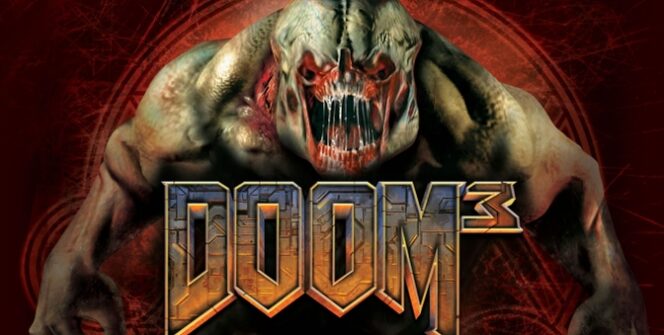
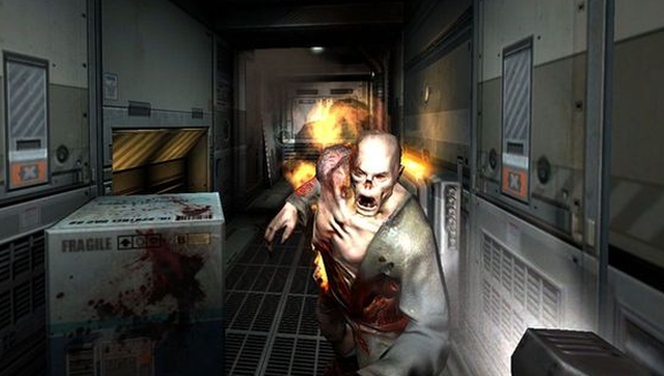

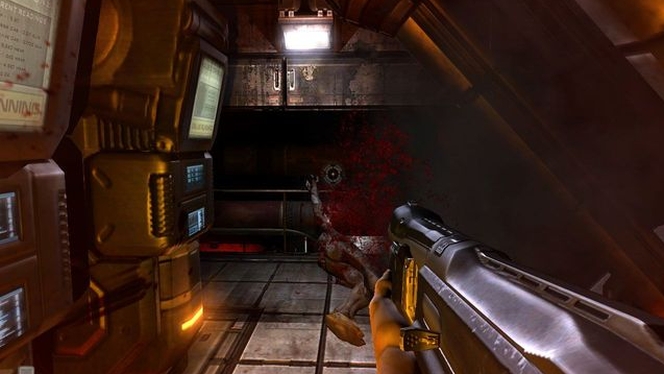
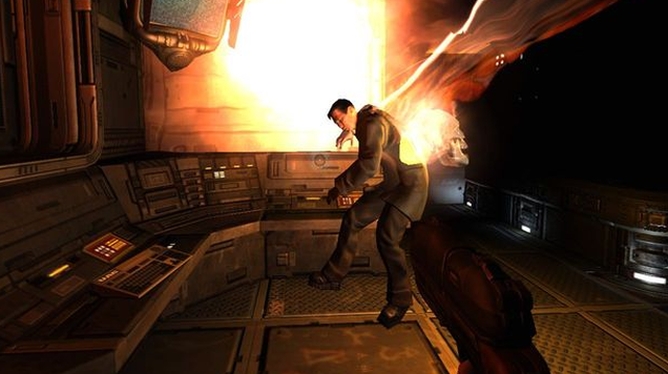
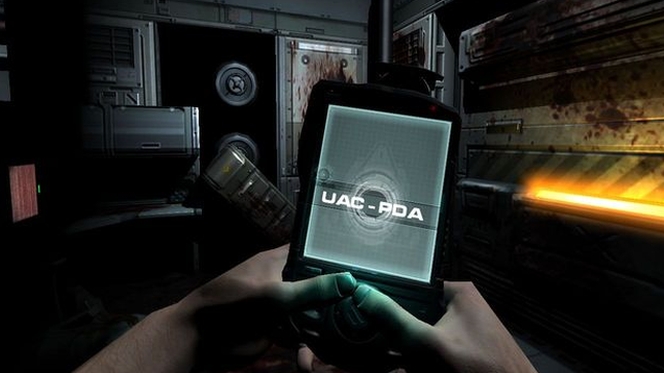
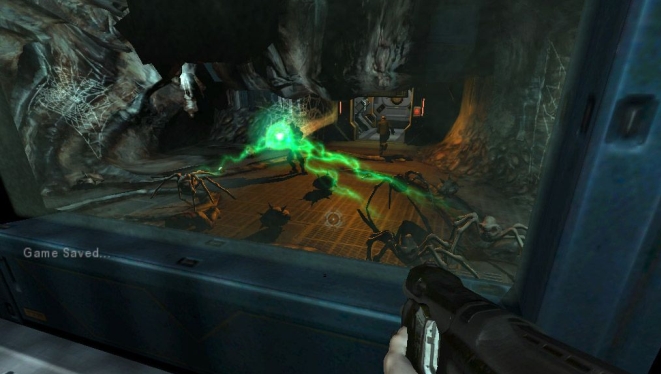














Leave a Reply